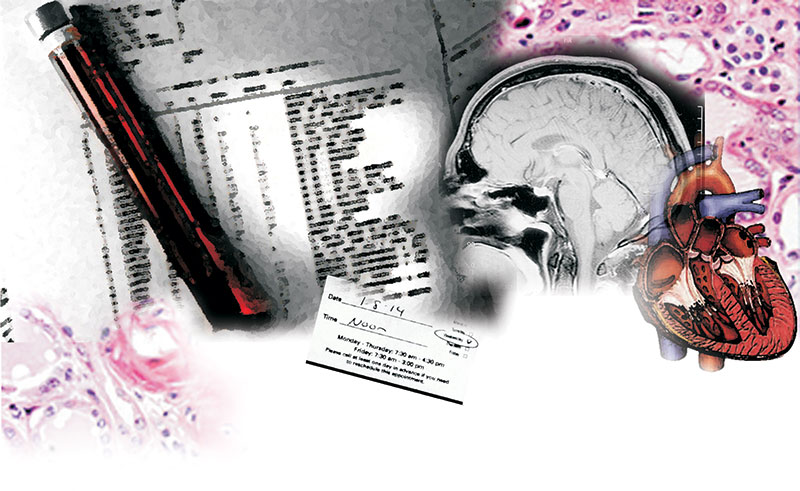For months, nobody could figure out what was wrong with Roland “Buddy” Hargrove. At 63, Hargrove had never been seriously ill until he had an irregular electrocardiogram during a routine physical in February 2011. That set off a chain of misdiagnoses and worsening symptoms, a correct diagnosis that came too late and the awful night of July 9, 2012, when Hargrove suddenly sat up in bed in his Virginia Beach home, eyes bulging and gasping for air, and died about an hour later. Hargrove had amyloidosis, a rare disease caused by a buildup of substances called amyloid proteins in one or more organs, in his case mainly the heart. It was the elusive reason for all his symptoms: shortness of breath, exhaustion, weight loss, red streaks on his face, feeling full after a few bites of food and a fainting episode that doctors first thought was a heart attack.
Today, Buddy’s widow, Jody Hargrove, is determined to raise awareness of amyloidosis. Her husband’s experience with a battery of medical appointments and tests—on his heart, digestive system, liver, bones and skin—isn’t unique. “The stories I’ve heard are just horrendous,” Hargrove says. “It often takes forever for people get diagnosed, and by then they’re too sick to have much of a chance. Buddy’s doctors did the best they could. They just didn’t know.”
Amyloidosis can affect different organs, and there are different types of amyloid. Symptoms, then, can be varied and vague, such as difficulty swallowing, an enlarged tongue, diarrhea or constipation, swelling of the ankles and numbness or tingling of the hands or feet. The cause is often unknown, but the form of the disease that strikes 70 percent of patients, primary or light-chain amyloidosis, originates in bone marrow much like the cancer multiple myeloma. With amyloidosis, cells produce a type of antibodies—proteins meant to protect against infections—that the body can’t break down.
While abnormal protein levels can appear in urine or blood tests, doctors often don’t order tissue biopsies to confirm amyloidosis. In heart patients, for example, they understandably suspect a more common artery or valve disorder, or they attribute thickening of the heart wall to high blood pressure. Buddy Hargrove’s doctors originally blamed a bad reaction to a cholesterol medication.
Doctors diagnose 3,000 to 5,000 cases of primary amyloidosis a year, but the real number is likely far higher and should climb as the population ages, says Mary O’Donnell, founder and president of the Michigan-based Amyloidosis Foundation (amyloidosis.org). O’Donnell’s 62-year-old husband, Donald Brockman, died of the disease in 2004 after being misdiagnosed for as many as seven years. When he had a bladder growth, for instance, doctors tested for cancer but not amyloidosis.
“Nothing really stands out that screams, ‘amyloidosis!’” she says. “Our goal is to allow the thought of it to creep into doctors’ minds—to do the tests if these symptoms are present and nothing is conclusive.”
Depending on the type of disease, lifesaving or life-prolonging treatment options can include medication, chemotherapy and stem cell transplants, along with lifestyle changes that may ease symptoms. Some 20 clinical trials are ongoing on new drugs, O’Donnell says.
And while the current approach targets cells that produce damaging proteins, an emerging and promising strategy could also help remove amyloid deposits in organs, says Dr. Raymond Comenzo, a hematologist at Tufts Medical Center in Boston, Mass., and a national specialist on amyloidosis. Dr. Comenzo sees about 50 new patients a year and finally diagnosed Buddy Hargrove—one week before his death—after a dermatologist happened to mention the disease name to his wife.
“There are a number of new things coming, but early diagnosis is extremely important, especially for people with heart involvement,” Dr. Comenzo says. “It’s also critical that patients get to a doctor who knows about amyloid—quickly.”
Those words come too late for Buddy Hargrove, a gentle, nature-loving soul who treated his wife “like a princess,” she reports. As she shares his story and distributes amyloidosis brochures to doctors, she thinks of a gift she received on her 31st wedding anniversary, which was the day after Buddy died. She had gone to a funeral home to identify his body.
“He looked so peaceful and pain free,” she says. “This is the image of him that I carry in my heart.”
Symptoms of Cardiac Amyloidosis
Some patients may have no symptoms. Those who do may experience:
- Excessive urination at night
- Fatigue, reduced activity tolerance
- Palpitations (sensation of feeling heart beat)
- Shortness of breath with activity
- Swelling of legs, ankles, or other part of the body (See: abdominal swelling)
- Trouble breathing while lying down
When to see a doctor
If you persistently experience any of the signs or symptoms that may be associated with amyloidosis, see your doctor to determine whether the underlying cause may be amyloidosis or another problem.







